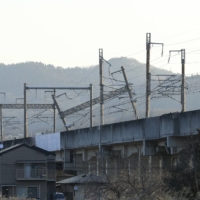It’s a scenario that would seem to be destined to end in disaster: A large earthquake strikes as a bullet train zips along elevated tracks at speeds of around 300 kilometers per hour.
But when a train on the Tohoku Shinkansen line derailed late Wednesday after a magnitude 7.4 earthquake struck off Japan’s northeastern coast, none of the 75 passengers or three crew members were injured.
Operator East Japan Railway Co. (JR East) says that safety measures introduced after a similar incident in the past helped prevent a catastrophe earlier this week when 16 of the 17 train cars derailed on a viaduct in Shiroishi, Miyagi Prefecture.
The company says, however, that it will be difficult to fully restore the service by the end of March due to damaged infrastructure — including piers and utility poles — demonstrating that some quake-proof installations were not sufficient for such a strong quake. The delay in relaunching full services has created concern over the impact on tourism in the region and the local economy as a whole.
Still, the high-tech systems installed on the train line kept passengers safe despite the quake, which registered an upper 6 on Japan’s seismic intensity scale — one below the top level — in parts of Miyagi and Fukushima prefectures.
Hitoshi Tsunashima, a professor of railroad engineering at Nihon University, who studied the images of the train’s interior and exterior on the internet, said, “The train must have been shaken sideways as well as up and down, and some of the cars may have derailed, as if they were jumping up.”
According to a 28-year-old passenger from Sendai, the train had been slowing down when the first earthquake alert was issued and stopped just before the second, more powerful quake hit. Tsunashima believes the emergency brakes triggered by the urgent earthquake detection and alarm system helped reduce the damage.
The system detects and analyzes data of the primary waves, known as P waves, which travel faster than the secondary waves (S waves), which in large quakes are accompanied by strong shaking.
In the event of a strong earthquake, seismographs installed along the line and other locations detect the P waves and estimate the location and scale of the epicenter. The system stops trains automatically by cutting power at selected sections.
The system also uses data from the Meteorological Agency’s earthquake alerts and undersea seismometers.
A halted train isn’t immune to derailments, however.
To guard against derailments, JR East has installed L-shaped metal parts on its train cars as a countermeasure. The parts are designed to hook the cars on the rails, thus preventing them from colliding with side walls. JR East developed the parts following the derailment of Joetsu Shinkansen cars after a powerful earthquake in Niigata Prefecture in 2004. All of the company’s bullet trains are equipped with the parts.
JR East has also taken measures to prevent trains from tipping by installing devices to fix the rails firmly in place so that they won’t tilt. The devices were installed on approximately 1,000 km of track, including at the site where Wednesday’s derailment occurred.
Transport ministry officials say such systems worked to reduce the damage to the train cars, though Wednesday’s quake showed large temblors can still take a toll on trains and surrounding infrastructure.
JR East has been promoting seismic reinforcement of areas on active fault lines following the 1995 Great Hanshin Earthquake and the 2011 Great East Japan Earthquake. But in February last year, when an earthquake measuring an upper 6 on the seismic intensity scale hit Fukushima and Miyagi prefectures, damage to structures and installations was confirmed in locations outside the areas where reinforcements had been completed.
Following last year’s earthquake, the company revised the priority areas for reinforcement and worked on seismic upgrades of utility poles at a pace approximately twice as fast as before, but the work will still take seven years to complete.
The firm has not been able to keep up with reinforcement work as a number of large earthquakes continue to occur.
Experts say it will take weeks to assess the full extent of the damage to the Tohoku Shinkansen line and carry out the necessary work to completely restore services.
The operator said that the section connecting Nasushiobara and Morioka stations will remain suspended until Monday, and full resumption of the line before the end of March may not be possible.
Following the 2004 Niigata quake, it took about two months to resume operations due to difficulties removing the cars amid continued aftershocks and other issues.
Such a delay would not be welcome news for either the company or the Tohoku region after over two years of poor economic conditions amid the pandemic.
The government has decided to fully lift the COVID-19 quasi-emergency next week, and JR East is hoping that tourists will flock to the Tohoku region during the Golden Week holidays. A prolonged suspension of shinkansen services would dampen the outlook for recovery.
“It is necessary to carefully verify whether the safety measures have worked,” said Totaro Ichikawa, JR East’s vice president. But he added, “Personally, I’d like to resume the service as soon as possible.”
In a time of both misinformation and too much information, quality journalism is more crucial than ever.
By subscribing, you can help us get the story right.
SUBSCRIBE NOW




